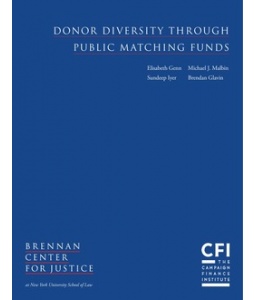Donor Diversity through Public Matching Funds
In May, the Brennan Center for Justice and the Campaign Finance Institute released a report on how public financing improves diversity of small donors and changes how candidates view potential donors and potential constituents. The report’s authors note that the data set is rather small, but the trends identified in the study show how robust public financing systems can shift candidate focus from corporate donors back to individual constituents. The report’s authors conclude that “[New York city’s] public financing system appears to have achieved one of its key goals — strengthening the connections between public officials and their constituents.”
New York City uses a public financing system for municipal election campaigns, which provides matching funds to candidates who qualify and agree to strictly adhere to campaign spending limits. The voluntary system has been in place since 1988 and is overseen by the non-partisan City Campaign Finance Board. The program started with a one-to-one match on $1,000 donations which was changed to a four-to-one match on $250 donations in 2001. For the 2009 election cycle, the ratio became a six-to-one match on $175 donations. Various proposals to adopt a statewide system of public financing for election campaigns in New York state have found advocates over the years, but, as yet, none has been adopted.
 Cover of the Brennan Center/Campaign Finance Institute Donor Diversity Report
Cover of the Brennan Center/Campaign Finance Institute Donor Diversity Report
For the report, the Brennan Center and CFI looked at small donors to the campaigns of the 2009 City Council candidates, who participated in the public campaign financing system and compared them to the small donors for the campaigns of the 2010 State Assembly candidates, who did not have access to the public financing system. In the City Council race, small donors (those who gave less that $175) made up about 30% of the candidate’s fundraising, and in the State Assembly race, small donors contributed less than 6%. According to the CFI in another report, municipal candidates using the public financing system raised 37% of their private money from donors giving less than $250, whereas candidates who did not use public financing raised a mere 15% of their private donor funds from donors giving less than $250.
Drawing on the differences in the donor data for the 2009 City Council election and the 2010 State Assembly elections, the Brennan Center and CFI make some exciting inferences about how public financing engages a broader expanse of the community in elections and better connects candidates with a more diverse populace. The report maps the data for small donors across “census block groups” to discover where the small donors come from, looking specifically at demographics such as household income, education levels, and racial distribution. Taking, for example, a predominately African-American and low income area in Brooklyn, the data shows that twenty-four times as many residents of these communities contributed to the City Council election candidates than to the State Assembly candidates (adjusted for overall contribution rates to campaigns, the figure may be closer to 17 times).
The figures confirm what the Brennan Center has learned in interviews with candidates: “the City’s matching funds led them to look to a more diverse set of donors.” While acknowledging the limitations of the data set, the authors of the report conclude there is support for the claim that small donor matching funds bring people into the political process who are traditionally less engaged in it and for the claim that public financing systems improve connections between public officials and their constituents by giving candidates an incentive to connect with a more diverse and broader array of constituents during their campaigns.
Chicago Appleseed believes that greater engagement of diverse populations in elections strengthens our government structures. We’re glad to see research demonstrating positive connections between public finance systems and candidate engagement with a diversity of constituents. The role of money in elections poses an ever more complicated landscape for candidates, our courts, and the public at large.
Although it has been argued that public financing of elections may act as an antidote to Citizens United, public financing for presidential elections has not had much traction. Furthermore, the Supreme Court found problems with an Arizona public financing law that attempted to level the playing field between a publicly funded candidate and one who has opted out of public financing because of big money donors. Nonetheless, there is serious need for campaign finance reform.
